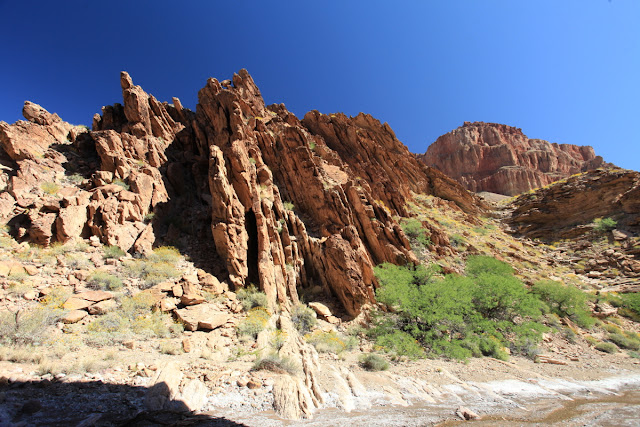One of the most well-known geology side hikes on a Colorado River trip in Grand Canyon is the Carbon Canyon/Lava Chuar Route, beginning at River Mile 63. This loop hike ascends the Carbon Creek drainage about one and a quarter miles to the intersection of the Butte Fault, then follows the fault for another one and half miles before descending back to the river in Lava Chuar Canyon for the final one and a quarter miles. There is a fantastic scenery (which is to say - geology) along every part of this loop.
Interesting boulder of Tapeats Sandstone with tafoni texture in the Carbon Creek drainage. There are a dozen or more of these here.
Iron concretions within the Dox Sandstone are always a curiosity begging an explanation. See this science article for a treatment of concretion formation.
Gigantic rock failure in Carbon Creek Canyon that necessitates a short but steep climb around it.
Jim and Billy resting after the climb on natural but well-positioned rock slab chairs.
Close-up of the Tapeats Sandstone showing its arkosic texture. The feldspar grains (pink) were derived from the Zoroaster Granite. But in this area of the canyon, the Tapeats rests entirely upon younger sedimentary rock units, so the feldspars were brought here from rocks not yet exposed in this part of the canyon.
Once on top of the giant rockfall, the creek is confined in a slot canyon within the Tapeats.
Narrow slot canyon along Carbon Creek.
And then, the canyon opens up at the site of, and along the trace of the Butte Fault. For an aerial view of the Butte Fault see this link.
More flowers, this one is the Indigo bush.
Full blooming brittle bush.
A small drainage built this delta fan along the trail. This is a small scale example of how the rapids form on the Colorado River, when side canyons deliver debris that partially constricts the river channel.
View of the Chuar Group rocks in eastern Grand Canyon. This is the only locale where these rocks are found in the Grand Canyon and at 790 to 740 Ma, they are some of the few rocks from this age anywhere on planet Earth.
Finally, after entering Lava Chuar Canyon on the way back to the Colorado River, the route passes by some great exposures of the Dox Sandstone, part of the Unkar group and about 1,100 Ma.
These well-preserved ripple marks were seen and are part of the Dox Sandstone.
I will be headed back down the river this Friday for my third trip of the year and will post more by the end of the month.














Wayne,
ReplyDeleteThank you for second post.
Wonderful to revisit our trip through your photos and comments.
Great fun and invigoratingly fascinating...the whole trip.
Thank you and Colorado Rivers and Trails.
Number 4
Wayne, thanks for sharing the pics on some of the great moments we enjoyed in this trip, it was an unbelievable experience
ReplyDeleteBest regards
Thanks for sharing the pics!
ReplyDeleteThanks for posting. Great photos!
ReplyDeleteThanks for posting. Great photos!
ReplyDelete